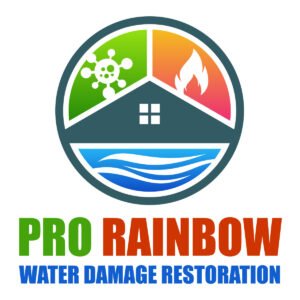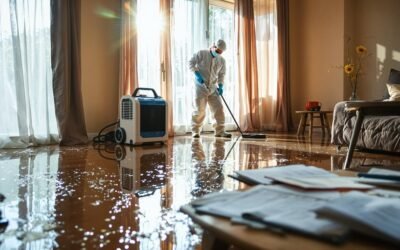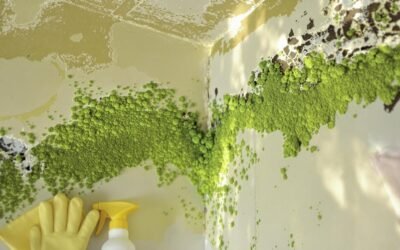To prevent mold from growing on wet drywall after water damage, you need to act quickly. First, assess the damage and use a wet/dry vacuum to remove excess water. Follow this by thoroughly drying the area with fans and dehumidifiers to maintain humidity levels between 30-50%. Incorporating mold-resistant drywall and paint can offer extra protection. Guarantee proper ventilation by using exhaust fans and keeping windows open for airflow. Finally, monitor humidity and inspect potential leak areas regularly to catch issues early. There's more crucial information to guarantee you effectively manage moisture and prevent mold growth.
Key Takeaways
- Assess and document water damage immediately to determine if drywall can be salvaged or needs replacement to prevent mold growth.
- Remove excess water quickly using a wet/dry vacuum and absorb additional moisture with towels to minimize mold risk.
- Thoroughly dry the area with fans and dehumidifiers, keeping humidity levels between 30-50% to discourage mold development.
- Use mold-resistant drywall, paint, and sealants to inhibit mold growth and protect surfaces from moisture penetration.
- Maintain proper ventilation by using exhaust fans, opening windows, and employing dehumidifiers to promote air circulation and reduce humidity.
Assess the Damage
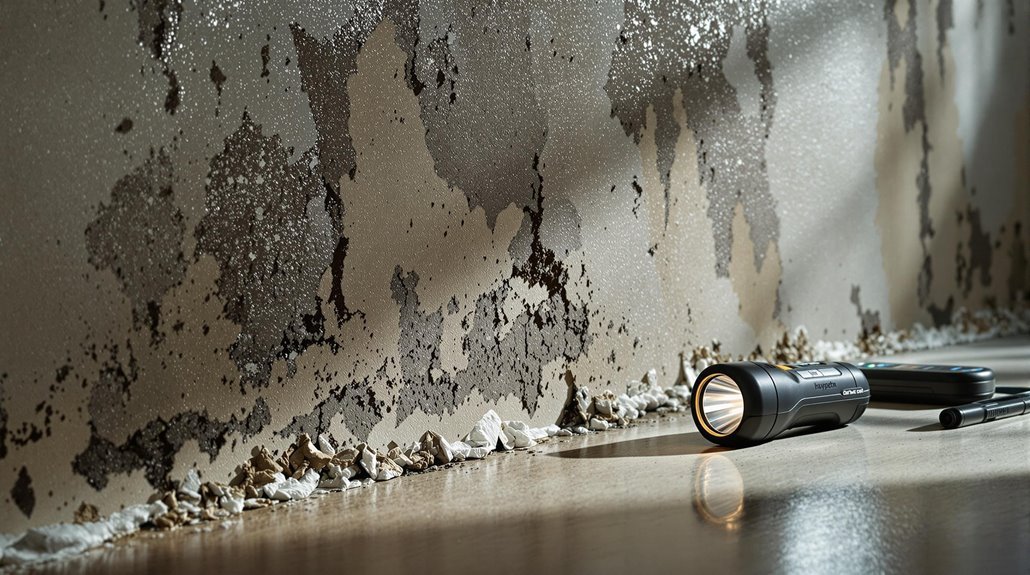
When you encounter wet drywall, the first step is to assess the damage in detail. Start by inspecting the affected area for visible signs of water exposure, such as sagging, discoloration, or bulging. Document any mold types you observe; common ones include black mold, green mold, and white mold, which can develop within 24 to 48 hours. Use a moisture meter to determine the extent of saturation, as this will inform your next steps. Pay attention to hidden areas like wall cavities and behind baseboards, where moisture can linger undetected. Conducting a thorough damage assessment will allow you to identify whether the drywall can be salvaged or needs replacement, ultimately helping you prevent further mold growth. Additionally, swift action is crucial to minimize damage and prevent mold growth in the affected areas.
Remove Excess Water
To effectively prevent mold growth on wet drywall, you must first remove excess water. Use a wet/dry vacuum to extract as much moisture as possible, ensuring you cover all affected areas. Follow up by absorbing any remaining moisture with towels to achieve a thorough dry. Additionally, rapid response to water damage is essential in minimizing the risk of mold growth.
Use Wet/Dry Vacuum
Start by employing a wet/dry vacuum to swiftly eliminate excess water from wet drywall. This tool offers significant wet/dry vacuum benefits, including powerful suction that effectively removes moisture. Begin by positioning the vacuum nozzle close to the surface of the drywall, using effective suction techniques to draw out water without causing further damage. Move the nozzle in overlapping strokes to guarantee thorough coverage. After vacuuming, check for moisture by feeling the surface; if it's still damp, repeat the process. Furthermore, consider using a smaller attachment for hard-to-reach areas, maximizing your vacuum's potential. By efficiently removing excess water, you'll create a less favorable environment for mold growth, thereby protecting your home from potential damage.
Absorb Moisture With Towels
After using a wet/dry vacuum to remove excess water from the drywall, it's important to further absorb any remaining moisture. Start by selecting appropriate towel types, such as microfiber or cotton, which are known for their high absorption capabilities. Next, employ effective absorption techniques: press the towel firmly against the wet areas, allowing it to soak up moisture, and replace it as it becomes saturated. For larger areas, consider using multiple towels simultaneously to expedite the process. If possible, wring out the towels outside to prevent adding moisture back into the environment. Once you've absorbed as much water as possible, it's essential to follow up with proper ventilation to guarantee the remaining moisture evaporates quickly, preventing mold growth.
Dry the Area Thoroughly
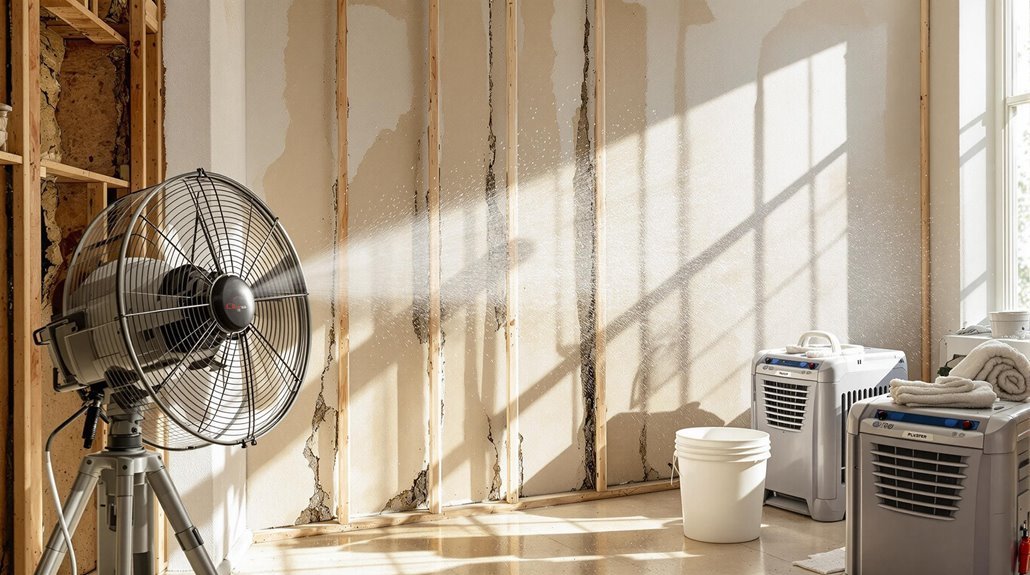
To effectively prevent mold growth, you need to dry the area thoroughly after water damage. Start by evaluating the extent of the damage, then use fans and dehumidifiers to expedite the drying process. Regularly monitor humidity levels to guarantee they remain low and discourage mold development.
Assess Water Damage Extent
While evaluating the extent of water damage, it's crucial to dry the area thoroughly to prevent mold growth. Start by identifying water damage indicators, such as discoloration, peeling paint, or a musty odor. These signs help you assess how far the damage has spread. Check behind furniture and within walls, as hidden moisture can lead to mold development. Use moisture meters to quantify dampness levels in drywall and surrounding materials. If you find saturated areas, prioritize drying those spots immediately. Remember, even minor water exposure can create ideal conditions for mold. By addressing these issues promptly and thoroughly, you improve your mold growth prevention efforts, ensuring a safer, healthier environment in your home.
Use Fans and Dehumidifiers
Using fans and dehumidifiers is vital for drying wet drywall effectively, as they work together to reduce moisture levels in the air and on surfaces. Proper fan placement is fundamental; direct the airflow toward the wet areas to maximize evaporation. Simultaneously, adjust your dehumidifier settings to maintain ideal humidity levels, typically between 30-50%.
Here are some tips to improve the drying process:
- Position fans in a cross-ventilation pattern.
- Use high settings on fans for maximum airflow.
- Empty the dehumidifier's reservoir regularly.
- Keep doors and windows closed to contain moisture.
- Monitor the drying progress daily.
Monitor Humidity Levels Regularly
Regularly monitoring humidity levels is crucial for preventing mold growth on wet drywall. To effectively manage humidity control, invest in a hygrometer to measure moisture levels in your environment. Ideal indoor humidity should be between 30-50%. If readings exceed this range, activate dehumidifiers or increase ventilation to reduce moisture.
Check humidity levels frequently, especially after water damage or heavy rain. Keep an eye on areas prone to dampness, such as basements and bathrooms. If you notice persistent high humidity, consider additional moisture control strategies, like sealing leaks and insulating walls. By staying vigilant with moisture measurement, you can create an environment less favorable to mold, ensuring your drywall remains dry and healthy.
Use Mold-Resistant Products
To effectively prevent mold growth on wet drywall, consider incorporating mold-resistant products into your building materials. These products are designed to withstand moisture and inhibit mold development. Using moisture-resistant drywall is essential, as it contains additives that resist moisture absorption. Furthermore, applying mold-resistant paint can provide an extra layer of protection, sealing surfaces and preventing mold spores from settling.
Here are some recommended mold-resistant products:
- Moisture-resistant drywall
- Mold-resistant paint
- Waterproof sealants
- Mold inhibitors for existing paints
- High-performance insulation materials
Maintain Proper Ventilation
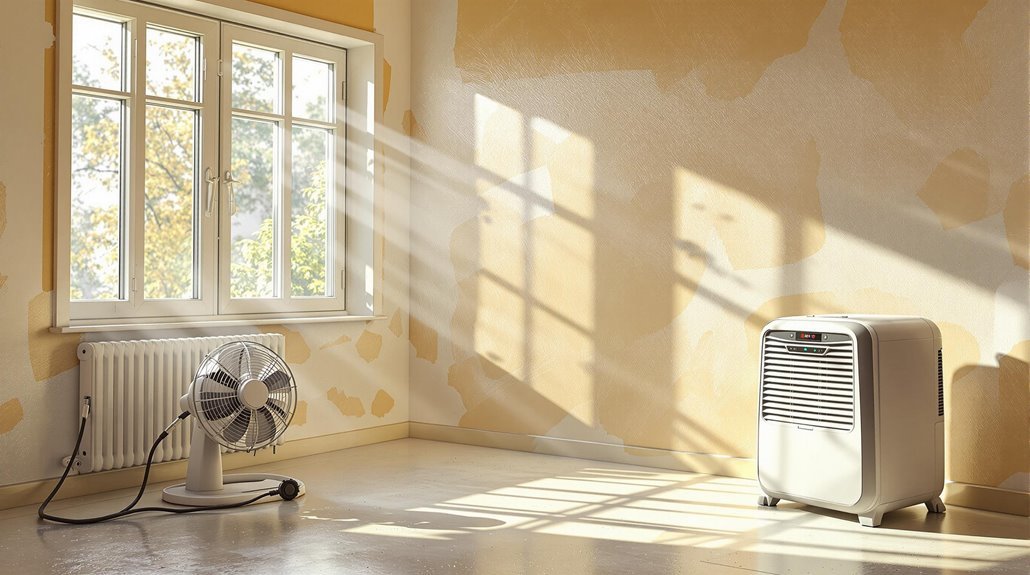
While you've taken steps to use mold-resistant products, maintaining proper ventilation is similarly crucial in preventing mold on wet drywall. Effective air circulation helps reduce humidity levels and promotes quicker drying. Implementing ventilation techniques like using exhaust fans in bathrooms and kitchens, opening windows, and utilizing dehumidifiers can greatly improve air movement.
Here's a simple overview of key ventilation techniques:
| Technique | Purpose | Benefits |
|---|---|---|
| Exhaust Fans | Remove moist air | Quick humidity reduction |
| Open Windows | Increase airflow | Natural ventilation |
| Dehumidifiers | Extract moisture from air | Maintains ideal humidity |
Monitor for Future Moisture
Since excess moisture can lead to mold growth even after initial remediation, it's vital to monitor your environment continuously. Implementing effective humidity control and moisture detection strategies helps prevent future issues. Regular checks can identify potential problems before they escalate.
- Use a hygrometer to measure indoor humidity levels.
- Inspect areas prone to leaks, such as basements and attics.
- Invest in moisture-detecting devices for early alerts.
- Maintain HVAC systems to guarantee proper airflow and humidity regulation.
- Keep an eye on windows and doors for condensation build-up.
Conclusion
To effectively prevent mold growth on wet drywall after water damage, it's essential to act quickly and decisively. Remember, mold can start to develop within 24-48 hours if conditions are right. By evaluating the damage, removing excess water, and ensuring thorough drying, you set a solid foundation against mold. Furthermore, utilizing mold-resistant products and maintaining proper ventilation will further safeguard your space. Stay vigilant; a proactive approach is your best defense against future moisture issues.
